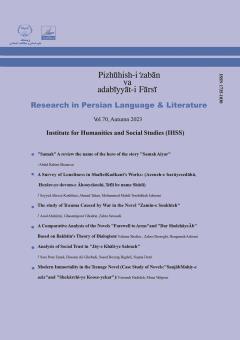In this research the author has elicited the marked semantic features / components of art concept in the poetry of 6th century with using the principles of conceptual semantics. With a critical and editorial look at the structures identified for conceptual semantics, h
More
In this research the author has elicited the marked semantic features / components of art concept in the poetry of 6th century with using the principles of conceptual semantics. With a critical and editorial look at the structures identified for conceptual semantics, he has reviewed these structures and their application in the field of linguistic and literary research. After classification of semantic features in relevant fields with every feature, fifteen various semantic fields acquired for art concept in the poems of 6th century poets. These semantic fields in order of extenting their domains are: literary language, practical wisdom, eulogy, aesthetics, craft, morality and habitude, social criticism, war, anthropology, zoology, religion, cosmology, ecology, mysticism and love. In literary language field, the diverse ontological phenomenon have been the materials for the poetical imagery with figurative devices, i.e. simile and implicit metaphor. In the semantic realm of praise, the art of the praiseworthy feature, incapable, has been reported against him. The components obtained in the field of aesthetics show that the poetry of the sixth century was the basis of the discourse of aesthetics. The semantic field of industry has been obtained from various techniques and professions. Individual and social characteristics are grouped in the semantic domain of morality and temperament. Non gratification of poets in 6th century from their art has conceptualized the semantic field of social criticism. Also warfare and the quality of martial instrumen are also marked for the concept of art. Art has also been enumerated in the field of anthropology of human habits and, nevertheless, has been considered as a feature of various animals. Theism, religion and requisite for earmarking the religion also conceptualized for art. Finally, art has been reported as a feature of the universe and cosmic objects and has been conceptualized with singular semantic features of ecology, mysticism and love. The research findings show that art has a very comprehensive concept in the framework of the mentioned studies and is contrary to the conventional notions of today. The research findings prove that art in the studied framework has a most comprehensive and despite to usual assumptions concept.
Manuscript profile


